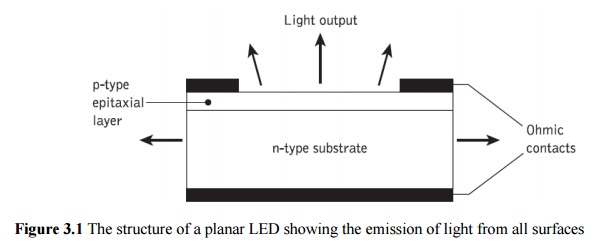Chapter: Optical Communication and Networking : Sources and Detectors
LEDs
LEDs
Spontaneous
emission of radiation in the visible and infrared regions of the spectrum from
a forward-biased p–n junction was discussed. The normally
empty conduction band of the semiconductor is populated by electrons injected
into it by the forward current through the junction, and light is generated
when these electrons recombine with holes in the valence band to emit a photon.
This is the mechanism by which light is emitted from an LED, but stimulated
emission is not encouraged, as it is in the injection laser, by the addition of
an optical cavity and mirror facets to provide feedback of photons.
The LED
can therefore operate at lower current densities than the injection laser, but
the emitted photons have random phases and the device is an incoherent optical
source. Also, the energy of the emitted photons is only roughly equal to the
band gap energy of the semiconductor material, which gives a much wider
spectral line width (possibly by a factor of 100) than the injection laser. The
line width for an LED corresponds to a range of photon energy between 1 and 3.5KT, where K is Boltzmann’s constant and T
is the absolute temperature.
This
gives linewidths of 30 to 40 nm for GaAs-based devices operating at room
temperature. Thus the LED supports many optical modes within its structure and
is therefore often used as a multimode source, although the coupling of LEDs to
single-mode fibers has been pursued with success, particularly when advanced
structures are employed. Also, LEDs have several further drawbacks in
comparison with injection lasers.
These
include:
ü generally
lower optical power coupled into a fiber (microwatts);
ü usually
lower modulation bandwidth;
ü harmonic
distortion.
However,
although these problems may initially appear to make the LED a less attractive
optical source than the injection laser, the device has a number of distinct
advantages which have given it a prominent place in optical fiber
communications:
ü Simpler fabrication. There
are no mirror facets and in some structures no striped geometry.
ü Cost. The simpler construction of the
LED leads to much reduced cost which is always likelyto be maintained.
ü Reliability. The LED does not exhibit
catastrophic degradation and has proved far lesssensitive to gradual
degradation than the injection laser. It is also immune to self-pulsation and
modal noise problems.
ü Generally less temperature dependence. The light
output against current characteristic is lessaffected by temperature than the
corresponding characteristic for the injection laser. Furthermore, the LED is
not a threshold device and therefore raising the temperature does not increase
the threshold current above the operating point and hence halt operation.
ü Simpler drive circuitry. This is
due to the generally lower drive currents and reducedtemperature dependence
which makes temperature compensation circuits unnecessary.
ü Linearity. Ideally, the LED has a linear
light output against current characteristic, unlike theinjection laser. This
can prove advantageous where analog modulation is concerned.
The
planar LED is the simplest of the structures that are available and is
fabricated by either liquid- or vapor-phase epitaxial processes over the whole
surface of a GaAs substrate. This involves a p-type diffusion into the n-type
substrate in order to create the junction illustrated in Figure 3.1. Forward
current flow through the junction gives Lambertian spontaneous emission and the
device emits light from all surfaces. However, only a limited amount of light
escapes the structure due to total internal reflection, and therefore the
radiance is low.

The
absence of optical amplification through stimulated emission in the LED tends
to limit the internal quantum efficiency (ratio of photons generated to
injected electrons) of the device. Reliance on spontaneous emission allows
nonradiative recombination to take place within the structure due to crystalline
imperfections and impurities giving, at best, an internal quantum efficiency of
50% for simple homojunction devices. However, as with injection lasers,
double-heterojunction (DH) structures have been implemented which recombination
lifetime measurements suggest give internal quantum efficiencies of 60 to 80%.
The power
generated internally by an LED may be determined by consideration of the excess
electrons and holes in the p- and n-type material respectively (i.e. the
minority carriers) when it is forward biased and carrier injection takes place
at the device contacts. The excess density of electrons Dn and holesDp is equal
since the injected carriers are created and recombined in pairs such thatcharge
neutrality is maintained within the structure.
Related Topics